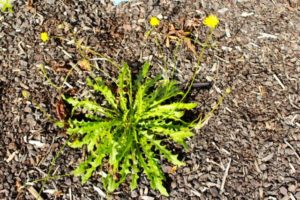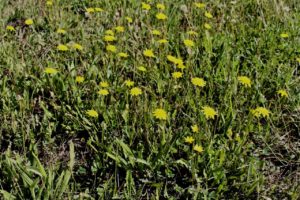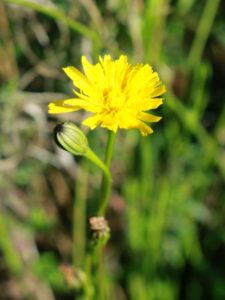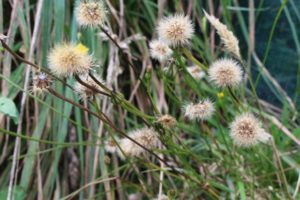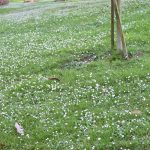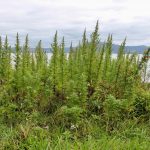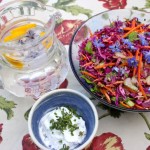In my travels around the country I have been enjoying seeing the bright yellow faces of Hawkbit (Leontodon taraxacoides) in the ditches like a yellow continuous ribbon to look at along the side of the roads. They are about the only flower you see (now they’ve stopped sowing wild flowers) along the miles of motorway strips between the lanes approaching Auckland. I was so enjoying seeing them while crawling in traffic I took photos on the cell phone.
Why is it the only flower you see in the ditches? I thought it may have become resistant to herbicides, but it didn’t
show up on any list. However, it is very quick to recover in places that are sprayed. Turns out herbicides do not induce resistance in weed species, rather they simply select for resistant individuals that naturally occur within the weed population. This shows their incredible resilience and adaptability in their genetic pool. Food for thought: is spraying not poisoning ourselves in the long run?
Hawkbit is in the dandelion family and is one of the four species we most commonly see in waste places,
lawns, roadsides, railway lines, pasture and gardens. We have it on a hillside of the farm that doesn’t get fertilised.
The distinguishing features of this dandelion species is a single, thin, solid, unbranched stem with one
flower, but it can have multiple flower stems. True Dandelion (Taraxacum officinale) has a large single flower, on a hollow stem, Hawksbeard (Crepis capillaris) has a smaller flower on leafy, taller, branched stems, and Catsear (Hypochaeris radicata) has thick rounded leaves, with a branched, leafless flower stem.
The curious name Hawkbit is said to come from medieval times when people thought hawks ate the plant to improve their eyesight. This may not be so superstitious since Hawkbit along with other dandelion species and many leafy greens contain high amounts of Vitamin C and bioflavonoids, both important antioxidants that help keep our eyes and body healthy. Hawkbit also contains Luteolin another bioflavonoid that has antioxidant, anti-inflammatory, and anti-tumour properties. In addition, Hawkbit contains protein, Vitamin A, B Vitamins, Calcium, phosphorus, Iron, Potassium and Magnesium.
You might say the leaves of all the dandelion species taste ‘yuk’ because they taste bitter, we need to re-educate our taste buds, as it is precisely this taste that is so important for digestion. It stimulates saliva, promotes the production of stomach acid and pepsin to break down protein, stimulates digestive enzymes and promotes bile flow to digest fats and oils. Bitters are tonic and help prevent disorders arising as Hippocrates said, “Let your food be your medicine and your medicine be your food”.
Be bold and try picking some wild dandelion species to include chopped finely in scrambled eggs along with chives and parsley, or steam and eat with lemon juice, salt and olive oil, put them in your smoothie along with other greens and fruit, pumpkin seeds, chia seeds and avocado. Young leaves chopped can also be included in your salads to add variety to the usual lettuce, increasing the diversity of your diet. This is one of my pet topics. People living in wilder places are known to eat 100’s of varieties of plants, whereas we in a western culture on average eat fifteen different plant species and they are often grown in mineral depleted soil, sprayed and bred for convenience or long shelf life. This is not providing us with optimum nutrition. Wild edibles are a solution. If you’d like to learn more visit my website www.juliasedibleweeds.com or attend a workshop Feb 26th or March 12th 2017 during Sustainable Backyards to register www.juliasedibleweeds.com/workshops
